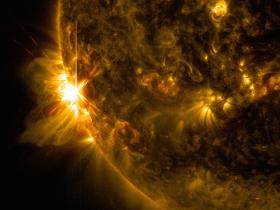High-energy particles fluxes produced by the solar flares are subject to the objective laws. This conclusion is made by Professor Rikho Nymmik, Leading researcher of D.V. Skobetsyn Institute of Nuclear Physics of M.V. Lomonosov Moscow State University as a result of his studies. He will tell about this achievement at the 40th COSPAR Scientific Assembly.
Due to the estimated regularities Rikho Nymmik got an opportunity to describe reliably and forecast the radiation conditions in space, to determine the most radiationally safe periods and orbits for interplanetary flights and to formulate the requirements to the design of the permanent inhabited bases on the surface of the Moon and the Mars.
“Once in a while bright point-like flares, called solar flares, happen at the Sun. During these flares different high-energy particles (with energy from 10 keV up to tens GeV) – protons, ions, electrons, neutrons, etc. - are accelerated. In some cases the fluxes of these particles escape from the solar atmosphere into the interplanetary space, where they undergo both additional acceleration and scattering and slowing down. The fluxes of solar energetic particles (SEP) produce potential radiation threat for the crew and equipment of the interplanetary spacecrafts and stations”, - Rikho Nymmik explained.
His research is based on the data of GOES (Geostationary Operational Environmental Satellite), IMP (Interplanetary Monitoring Platform), ACE (Advanced Composition Explorer), «Meteor» (series of meteorological satellites) and ground-based network of neutron monitors for the studies of high-energy cosmic particles.
Rikho Nymmik estimated a number of regularities of the SEP fluxes, three of which will be presented in details in his COSPAR contributions С01.14; С01.15; С01.16:
1. The SEP events frequency depends on the level of global solar activity (C01.14).
Sunspots number is one of the solar activity indices. Sunspots are temporary phenomena in the solar atmosphere, rather, photosphere, which appear as dark spots. They result from the local variations of the solar magnetic field, which are accompanied by the appearance of the regions with reduced temperature on the solar surface. Rikho Nymmik found out that average frequency of the SEP events is in proportion to the sunspots number.
2. The number of protons, which constitute the major portion of the SEP events observed near the Earth, depends on: their portion in the total SEP flux, the characteristics of the protons propagation, scattering and acceleration in their way to the Earth (C01.15).
3. The number of the particles in the SEP flux decreases with the energy increasing (C01.16).
The higher the particles' energy is the deeper the particles penetrate into the matter, for instance, into the protective screen of the spacecraft or into the cosmonaut's body.
Studying the regularities Rikho Nymmik found out that it is necessary to specify more strict requirements to the radiation protection of the equipment and humans during the long-duration space missions and design the bases on the other planets and the Moon, than it was done until recentely.
Oral contributions by Rikho Nymmik will take place on August 4 at: Lomonosov prospect 27, Bldg. 4 (Shuvalovsky Building), room S2-11.
At 9:45 - C01.13 «Regularities inherent Solar Energetic Particle events and fluxes which define properties interplanetary radiation field».
At 10:00 - C01.14 «Dependence of the SEP events frequency from the level of global solar activity».
At 10:15 - C01.15 «SEP distribution function and probability of limit values of events».
At 10:30 - C01.16 «True form of large-scale solar energetic particle energy spectrum and radiation doses.

